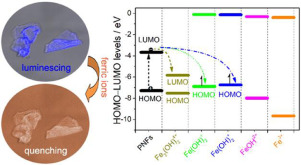当前位置:
X-MOL 学术
›
Microchem. J.
›
论文详情
Our official English website, www.x-mol.net, welcomes your
feedback! (Note: you will need to create a separate account there.)
Fluorescence quenching of photoluminescent organic polymer nanofilms by ferric ions
Microchemical Journal ( IF 4.9 ) Pub Date : 2020-05-01 , DOI: 10.1016/j.microc.2020.104639 Baoxi Feng , Zhen Xu , Chenggang Qi , Xiumei Guo , Ligang Gai
Microchemical Journal ( IF 4.9 ) Pub Date : 2020-05-01 , DOI: 10.1016/j.microc.2020.104639 Baoxi Feng , Zhen Xu , Chenggang Qi , Xiumei Guo , Ligang Gai

|
Abstract There are considerable reports on fluorescent detection of ferric ions, which were universally simplified as Fe3+, by using carbon dots-based sensors. Although several mechanisms have been proposed for the fluorescence quenching of the host, it deserves deep understanding on this topic because the hydrolysis of Fe3+ has not been considered in previous reports. In this contribution, we report on fluorescent detection of ferric ions in mixed metal-ion solution and in real water with organic polymer nanofilms (PNFs)-based sensor. The limit of detection of PNFs towards ferric ions is 44 nM. In particular, we focus on demonstration of the fluorescence quenching mechanisms through instrumental analysis and theoretical computations. The electron transfer from the LUMO level of PNFs to the LUMO level of Fe2(OH)24+ and the HOMO levels of Fe(OH)2+ is suggested to be responsible for the impressive fluorescence quenching of PNFs by ferric ions with concentration lower than 80 µM.
中文翻译:

三价铁离子对光致发光有机聚合物纳米膜的荧光猝灭
摘要 使用基于碳点的传感器对普遍简化为 Fe3+ 的三价铁离子进行荧光检测已有大量报道。尽管已经提出了几种用于主体荧光猝灭的机制,但由于之前的报告中没有考虑 Fe3+ 的水解,因此值得对此主题进行深入了解。在这篇文章中,我们报告了使用基于有机聚合物纳米膜 (PNF) 的传感器对混合金属离子溶液和真实水中的三价铁离子进行荧光检测。PNF 对三价铁离子的检测极限为 44 nM。特别是,我们专注于通过仪器分析和理论计算来证明荧光猝灭机制。
更新日期:2020-05-01
中文翻译:

三价铁离子对光致发光有机聚合物纳米膜的荧光猝灭
摘要 使用基于碳点的传感器对普遍简化为 Fe3+ 的三价铁离子进行荧光检测已有大量报道。尽管已经提出了几种用于主体荧光猝灭的机制,但由于之前的报告中没有考虑 Fe3+ 的水解,因此值得对此主题进行深入了解。在这篇文章中,我们报告了使用基于有机聚合物纳米膜 (PNF) 的传感器对混合金属离子溶液和真实水中的三价铁离子进行荧光检测。PNF 对三价铁离子的检测极限为 44 nM。特别是,我们专注于通过仪器分析和理论计算来证明荧光猝灭机制。











































 京公网安备 11010802027423号
京公网安备 11010802027423号